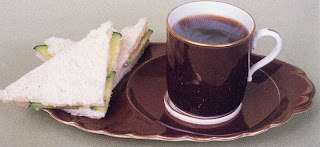Whenever the Wimbledon Tennis Championships are on I think of the links between Spode and tennis. Surprised? But yes, of course, there are connections.
I recall that the
Lawn Tennis Museum at Wimbledon has some Spode pieces in its collection made during the Copeland ownership of the company. It includes a jelly/blancmange mould with crossed tennis rackets, tennis balls and nets as the design. I would have liked to have to seen (and perhaps tasted) the jelly/blancmange made from it! Other objects were made too, sometimes in conjunction with a metalware manufacturer, for example a ceramic dish fitting into a suitably tennis-themed, silver-plated stand.
 |
| Tennis Set c1869 |
Tennis as we know it today began to blossom in the 1860s/1870s and could be a genteel affair for the well-to-do with elegant
tennis parties. The Spode company made some of the most exquisite pieces at this period known as tennis sets. These comprised a teacup or coffee cup on an elongated 'saucer' which left room for a delicate cucumber sandwich or similar by the cup.
Interestingly these were aimed at the highest end of the market with renowned Spode artists painting the intricate and beautiful designs (the Spode pattern books record the names) and with raised and chased gold decoration on the finest bone china.
They seem to be uncommon...the one illustrated above is a plainer version. But it is still decorated with a complicated and expensive method known as '
groundlaying' in a deep crimson and is also gilded. This shape design was registered with the British Patent Office in July 1869.
The quite amazing tennis set from the Met Museum, where it is simply described as a cup and saucer, would have been one of the most expensive designs to buy. With a saucer shaped as a leaf it shows the skill of the ceramics artists and designers. Just look at the way the exquisite pure white of Spode's translucent
bone china is left undecorated to great effect. It has beautifully handpainted autumnal colours to the leaf moulding; and the gold was burnished and chased after firing - a very sophisticated and skilled finish to the gilding.
In about 1870 the 'tennis set' shape was also used for a beautifully handpainted and gilded Christmas pattern of holly and mistletoe presumably unconnected with tennis but perfect for coffee and a mince pie!
Later in the 20th century this elongated shape was revived by Spode as the slightly more mundane 'TV plate' to accompany that new-fangled invention, and later still, in the early 21st century, as a 'tea and toast' set.
 |
| Spode Wimbledon centenary plate (detail), 1977 |
In 1977 for the centenary of the Wimbledon Lawn Tennis Club Spode produced a plate to celebrate the occasion, decorated in the club colours and featuring crossed tennis racquets, presented in a satin-lined box.
Another Stoke-on-Trent pottery manufacturing family, the
Shelleys were responsible for introducing tennis to North Staffordshire. Thank you to my sister,
Val Bott, for the research. She, with our parents and brother, owned and lived in the Shelley's house,
The Southlands, for a time. I didn't exist then so was born too late for this treat! The tennis courts were, I believe, still there in the grounds at that time.











